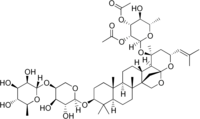Ziziphin
Appearance

| |
| Identifiers | |
|---|---|
3D model (JSmol)
|
|
| ChemSpider | |
PubChem CID
|
|
CompTox Dashboard (EPA)
|
|
| |
| Properties | |
| C51H80O18 | |
| Molar mass | 981.17 g/mol |
| Density | 1.345 g/cm3 |
Except where otherwise noted, data are given for materials in their standard state (at 25 °C [77 °F], 100 kPa).
| |
Ziziphin, a triterpene glycoside which exhibits taste-modifying properties, has been isolated from the leaves of Ziziphus jujuba (Rhamnaceae).
Among ziziphin's known homologues found in this plant, it is the most anti-sweet. However, its anti-sweet activity is less effective than gymnemic acid 1, another anti-sweet compound glycoside isolated from the leaves of Gymnema sylvestre (Asclepiadaceae).[1]
Ziziphin reduces perceived sweetness of most of the carbohydrates (e.g. glucose, fructose), bulk sweeteners, intense sweeteners (natural: steviol glycoside – artificial: sodium saccharin and aspartame) and sweet amino acids (e.g. glycine). However, it has no effect on the perception of the other tastes, bitterness, sourness and saltiness.[2]
See also
References
- ^ Kinghorn, A.D. and Compadre, C.M. Alternative Sweeteners: Third Edition, Revised and Expanded, Marcel Dekker ed., New York, 2001. ISBN 0-8247-0437-1
- ^ Kurihara, Y. (1992). "Characteristics of antisweet substances, sweet proteins, and sweetness-inducing proteins". Crit. Rev. Food Sci. Nutr. 32 (3): 231–252. doi:10.1080/10408399209527598. PMID 1418601.
